Are you looking to boost your design game, streamline your creative process, or simply understand the massive impact of a global design phenomenon?
Then you’ve come to the right place! Canva has revolutionized how we approach visual communication, making professional-quality design accessible to everyone.
This in-depth article dives into the most crucial Canva statistics for 2025, revealing its incredible growth, widespread adoption, and how you can leverage its power for your benefit.
The Design Revolution: Canva’s Rise to Prominence
Canva, founded in 2013 by Cliff Obrecht, Melanie Perkins, and Cameron Adams in Sydney, Australia, has rapidly transformed the design landscape.
It empowers millions of creators to produce stunning and impactful visuals, democratizing design for individuals and large organizations alike.
From small businesses crafting their first social media post to Fortune 500 companies optimizing their branding, Canva provides a powerful yet easy-to-use solution.
Let’s explore the key figures that highlight Canva’s remarkable journey and its current standing in the digital world.
Canva at a Glance: Top Statistics for 2025
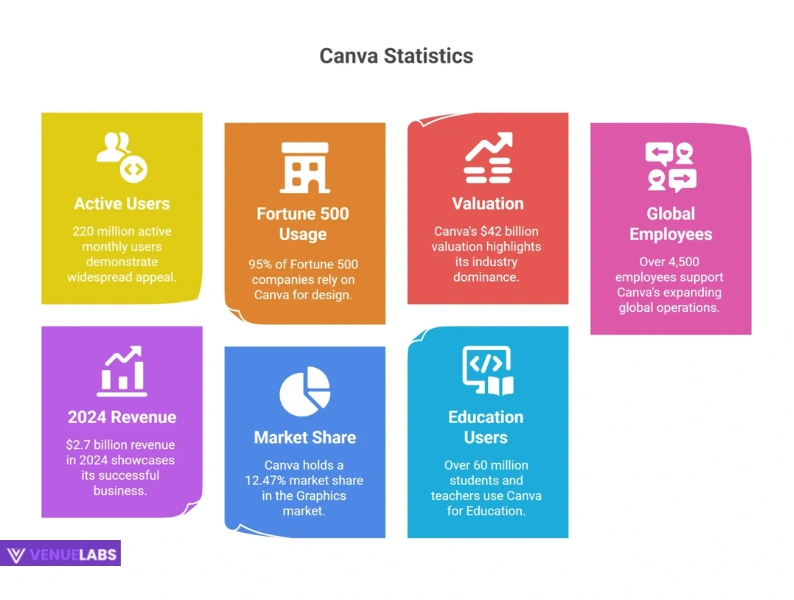
Canva’s impact is undeniable, and these top statistics for 2025 paint a clear picture of its dominance:
- 220 million active monthly users (AMU): A testament to its widespread appeal and daily utility.
- 95% of Fortune 500 companies use Canva: Major corporations trust Canva for their design needs.
- $42 billion valuation: Canva stands as a giant in the tech and design industries.
- Over 4,500 employees worldwide: A rapidly expanding team supports its global operations.
- $2.7 billion revenue in 2024: Its financial success underscores its effective business model.
- 12.47% market share in the Graphics market: Canva holds a significant position against established competitors.
- Over 60 million students and teachers use ‘Canva for Education’: A vital tool for learning and teaching globally.
Who is Using Canva? Unpacking the User Base
Canva’s user base is not just vast; it is incredibly diverse. Understanding who uses Canva and how they use it helps us appreciate its versatility.
Canva’s Explosive User Growth
Canva has experienced extraordinary user growth, making it a household name for design.
- 220 Million Active Monthly Users (AMU): As of 2025, a staggering 220 million people actively use Canva each month.
- 21 Million Paying Subscribers: A significant portion of its user base happily invests in Canva Pro for enhanced features.
The growth trajectory has been particularly steep in recent years. Between 2019 and 2021, the platform added 80 million users. The largest single-year increase occurred in 2022, with an additional 50 million users joining. In 2024, Canva saw another substantial jump, gaining 35 million new users.
Here’s a detailed look at Canva’s user growth over the years:
| Year | Number Of Canva Users (Millions) |
| 2019 | 30 |
| 2020 | 40 |
| 2021 | 60 |
| 2022 | 110 |
| 2023 | 135 |
| 2024 | 220 |
Also read about: Canva Free Trial 2025: Your Step-by-Step Guide to Get Canva Pro Free
Canva’s Global Reach: Users by Country
Canva’s influence spans nearly every corner of the globe, connecting creators in 190 countries—that’s 97.4% of nations worldwide!
| Country | Share of Canva Use |
| The United States | 14.38% |
| Brazil | 11.92% |
| Indonesia | 5.9% |
| Mexico | 5.57% |
| India | 5.26% |
| Others | 56.96% |
The United States consistently sends the highest traffic to Canva, demonstrating its strong presence in the North American market. However, vibrant communities in Brazil, Indonesia, Mexico, and India also contribute significantly to its global user base.
Demographics of Canva Users: A Diverse Creative Community
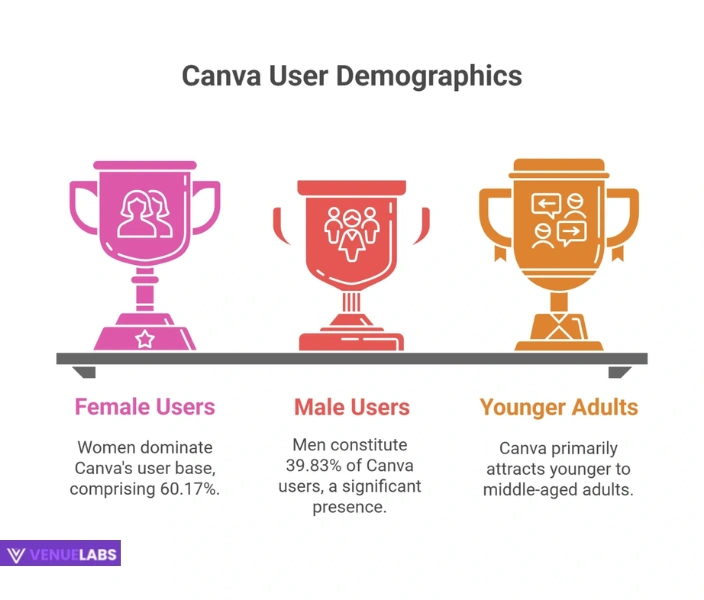
Canva’s appeal cuts across various demographic groups, empowering everyone from young entrepreneurs to seasoned professionals.
- Gender Distribution: Women make up a larger portion of Canva users, with 60.17% being female and 39.83% male. This trend shows an increase from 55% female users in 2022 to 60% in 2023, highlighting Canva’s strong resonance with female creators.
- Age Groups: The platform primarily attracts younger to middle-aged adults, demonstrating its relevance for modern communication and business.
| Age Group | Canva Users Share |
| 18 to 24 years | 21.77% |
| 25 to 34 years | 31% |
| 35 to 44 years | 20.22% |
| 45 to 54 years | 13.32% |
| 55 to 64 years | 8.56% |
| More than 65 years | 5.13% |
The 25 to 34 age group represents the largest segment of Canva users, suggesting its strong adoption among professionals and young adults entering the workforce.
Also read about: How To Make Money Using Canva 2025: ✨ Proven Strategies!
Industries Embracing Canva: Where Design Meets Business
Canva’s versatility makes it invaluable across numerous industries, with particular strength in sectors that prioritize visual communication.
- Education Leads the Way: The education and non-profit sectors utilize Canva most frequently, largely due to specialized plans that offer free or reduced-cost access.
- Corporate Adoption: Canva serves over 83,000 companies, ranging from small enterprises to large corporations.
Here’s a breakdown of Canva customers by industry:
| Industry | Canva Customers |
| Higher Education | 15% |
| Non-profit Organizations | 7% |
| Marketing & Advertisement | 6% |
| Information Technology | 5% |
| Education Management | 4.5% |
| Computer Software | 4% |
| Retail | 3% |
| Internet | 3% |
| Real Estate | 3% |
| Others | 51.5% |
Fortune 500 Companies Thrive with Canva
Major corporations increasingly turn to Canva to optimize their design workflows and achieve significant cost savings.
- 85% of Fortune 500 Companies Use Canva: This impressive figure includes industry giants like FedEx, L’Oréal, Salesforce, Zoom, and Starbucks.
- Proven ROI: Companies report substantial returns on investment. Salesforce, for example, achieved a remarkable 66% reduction in cost per design and a 63% increase in design production by integrating Canva.
These companies choose Canva for its ease of use, robust collaboration features, and broad functionality, which empower their teams to produce high-quality visuals efficiently.
Canva’s Financial Powerhouse: Revenue and Valuation
Canva’s financial performance is as impressive as its user growth, cementing its status as a highly successful global company.
Skyrocketing Revenue
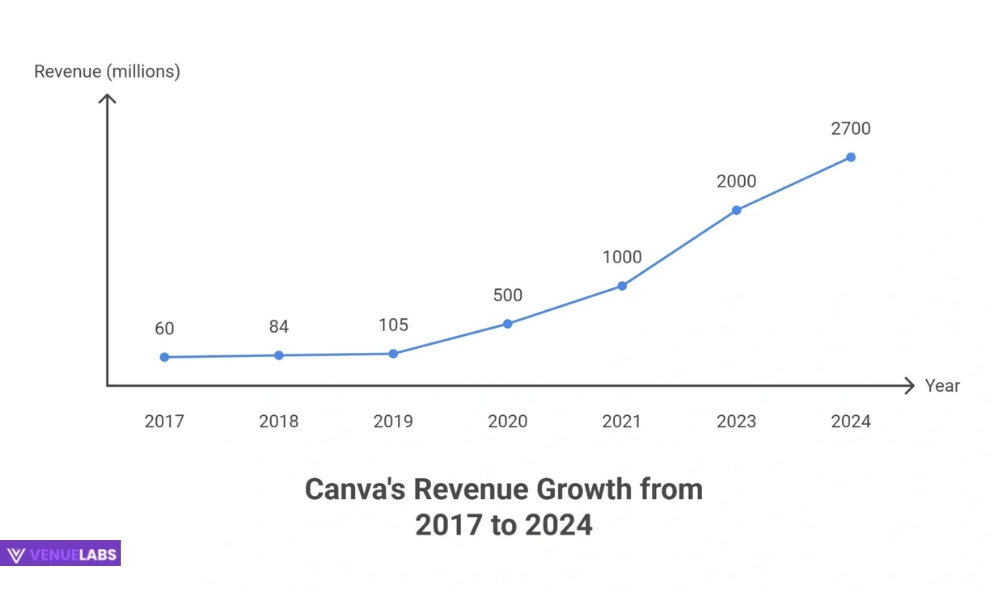
- $2.7 Billion Revenue in 2024: Canva’s revenue has seen consistent and strong year-over-year growth, increasing by 35% compared to previous years.
- Consistent Growth: The company’s revenue has grown dramatically, especially between 2019 and 2021, showcasing its rapid market penetration and successful monetization strategy.
| Year | Revenue Generated by Canva (Millions) |
| 2017 | $60 |
| 2018 | $84 |
| 2019 | $105 |
| 2020 | $500 |
| 2021 | $1,000 |
| 2023 | $2,000 |
| 2024 | $2,700 |
A Multi-Billion Dollar Valuation
- $42 Billion Valuation in 2025: While experiencing some fluctuations, Canva maintains a formidable valuation, reflecting investor confidence in its long-term potential. The valuation peaked at $54.5 billion in 2021.
| Year | Canva Valuation (Billions) |
| 2021 | $54.5 |
| 2023 | $38.5 |
| 2024 | $49 |
| 2025 | $42 |
Significant Funding Rounds
Canva has successfully raised substantial funding to fuel its expansion and innovation.
- Total Funding of $969 Million by Q2 2025: Strategic funding rounds have allowed Canva to invest in product development, market expansion, and acquisitions.
- Key Funding Milestones: Notable funding rounds include $155 million in 2019 and $271 million in 2021, with a massive $569 million in September 2023 and $400 million in May 2024.
| Month, Year | Amount (Millions) | Round |
| May 2019 | $70.0 | Series D |
| Oct 2019 | $85.0 | Series D |
| Jun 2020 | $60.0 | Late VC |
| Apr 2021 | $71.0 | Late VC |
| Sep 2021 | $200 | Late VC |
| Sep 2023 | $569 | Late VC |
| May 2024 | $400 | Growth Equity VC |
| Aug 2025 | $969 | Secondary |
Canva’s Competitive Edge: Market Share
Canva has carved out a significant niche in the highly competitive graphics design market, challenging long-standing industry leaders.
- 12.47% Market Share in Graphics: Canva stands as the third-largest player in the graphics market, a testament to its user-friendly approach and extensive features.
- Challenging the Giants: While Adobe Photoshop and InDesign hold larger shares, Canva’s rapid growth indicates its strong appeal to a broad audience, including those who may not be professional designers.
| Graphics Tool | Market Share |
| Adobe Photoshop | 40.94% |
| Adobe InDesign | 25.32% |
| Canva | 12.47% |
| Adobe Illustrator | 11.84% |
| SketchUp | 3.85% |
| Cinema 4D | 1.68% |
| CorelDRAW | 1.25% |
| Others | 2.65% |
Canva in Action: Usage Statistics
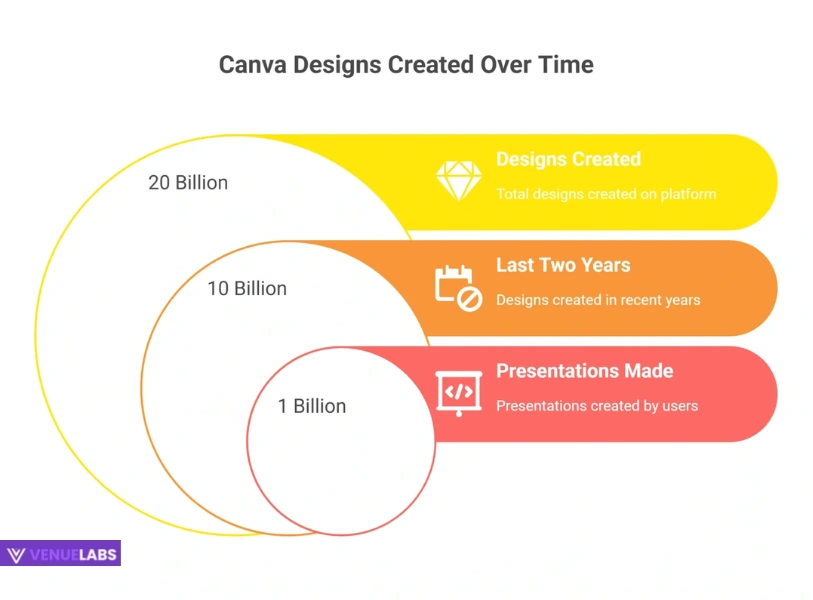
The sheer volume of designs created on Canva highlights its immense utility and popularity.
- Over 20 Billion Designs Created: This astounding number showcases the platform’s role as a creative engine. A remarkable 10 billion of these designs came to life in just the last two years.
- 200 Designs Every Second: This translates to 8.6 million designs created daily, demonstrating constant activity on the platform.
- Billions of Presentations: Users have created over 1 billion presentations and slideshows on Canva, along with 160 million infographics and 200 million business cards.
- Vast Content Library: Canva provides an enormous library of resources:
- 6,056 Fonts: With 985 English fonts and 5,071 in other languages, offering immense typographic flexibility. ‘Amiro’ is the most popular font, used in over 13.5 billion designs!
- 100 Million+ Images, Graphics, and Video Elements: Including 75 million premium assets.
- 610K Templates: With 350K premium options, offering a starting point for virtually any design need.
Canva’s Digital Footprint: Traffic Share
Canva’s website experiences massive traffic, reflecting its status as a go-to platform for design.
- 681 Million Monthly Visits: Canva.com attracts a colossal audience each month.
- Engaged Users: Visitors spend an average of 8 minutes and 17 seconds per visit, exploring 6.69 pages, indicating high engagement.
- Direct Traffic Dominates: A significant 71.15% of traffic comes directly to Canva.com, underscoring its brand recognition. Organic search contributes over 25.32%.
- Social Media Power: YouTube is the leading social media platform driving traffic to Canva (33.63%), followed by Facebook (23.88%) and WhatsApp Web (16.1%).
| Social Media Platforms | Percentage Of Traffic |
| YouTube | 33.63% |
| 23.88% | |
| Whatsapp Web | 16.1% |
| 6.78% | |
| Facebook Messenger | 6.48% |
| Others | 13.13% |
Canva for Education: Empowering Learning
Canva for Education has become an indispensable tool for students and teachers worldwide, fostering creativity and collaboration in the classroom.
- Over 60 Million Students and Teachers: This number has more than doubled from 25 million in 2022, showcasing rapid adoption.
- Free Resources: Launched in 2020, Canva for Education offers K-12 teachers and students free access to thousands of educational templates and design tools, transforming learning experiences.
- Global Impact: It operates in over 3,500 districts and 190 nations, with 50,000 education templates. In a significant move, the Los Angeles Unified School District (LAUSD), with over 640,000 students, adopted Canva for Education accounts.
| Year | Canva for Education Users (Millions) |
| 2020 | 8 |
| 2022 | 25 |
| 2023 | 50 |
| 2024 | 60 |
Canva for Nonprofits: Amplifying Causes
Canva extends its reach to nonprofit organizations, providing them with powerful design tools to engage communities and amplify their impact.
- Over 585,000 Nonprofit Organizations: This number has more than doubled from 250,000 in 2022.
- 800,000+ Users: Over 800,000 individuals within these nonprofits leverage Canva to create compelling visuals and promote their causes effectively.
The Team Behind the Magic: Canva Employees
Canva’s rapid growth necessitates a robust and expanding team.
- Over 4,500 Employees Worldwide: Canva’s workforce has significantly grown, especially during periods of high demand. In 2021 alone, it hired 1,350 new employees.
- Global Presence: Employees are based in key locations such as the United States, London, Manila, Sydney, Wuhan, and Beijing.
- High Employee Satisfaction: Glassdoor reports that 88% of Canva employees would recommend working at the company to a friend, and Canva has received “Best Workplace” awards, reflecting a strong company culture.
Strategic Expansion: Canva Acquisitions
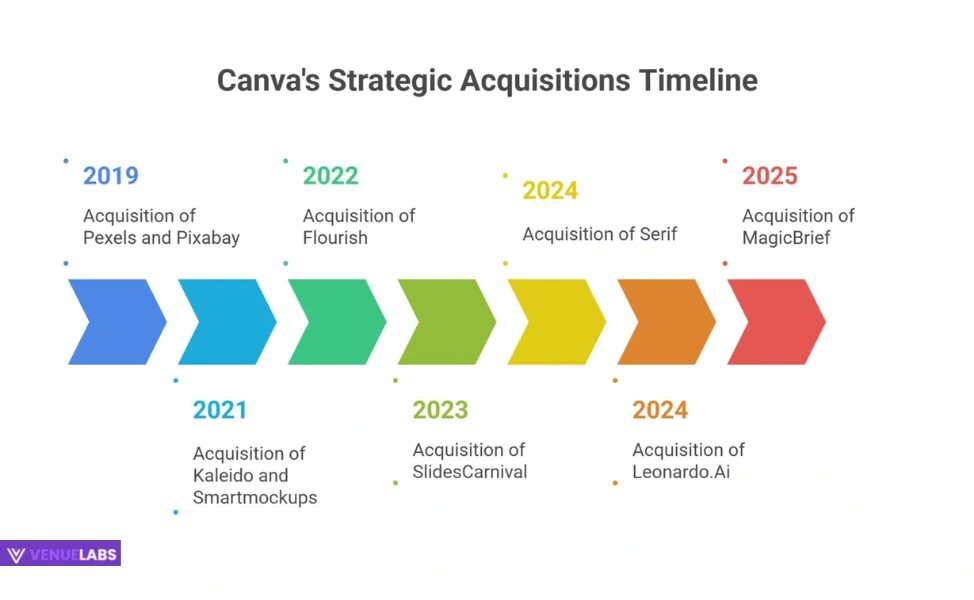
Canva has strategically acquired several companies to broaden its offerings and enhance its comprehensive design solution.
- 7 Acquisitions in the Last Six Years: Canva’s acquisitions focus on sectors like Enterprise Tech and Consumer Digital, expanding its capabilities across various design functionalities.
- Key Acquisitions: Notable acquisitions include:
- Pexels and Pixabay (2019): Boosting its stock media library.
- Kaleido and Smartmockups (2021): Adding advanced editing and mockup tools.
- Flourish (2022): Enhancing data visualization.
- SlidesCarnival (2023): Expanding presentation template options.
- Serif (2024): A major move into professional desktop publishing tools, signaling a deeper push into pro design.
- Leonardo.Ai (2024): A significant step into AI-powered image generation, addressing a growing user demand for quick, custom visuals.
- MagicBrief (2025): Integrating AI-powered content creation and design brief generation, further streamlining the creative workflow.
| Acquisition Date | Company Name | Location |
| Apr 24, 2018 | Zeetings | Australia |
| May 17, 2019 | Pexels | Germany |
| May 17, 2019 | Pixabay | Germany |
| Feb 23, 2021 | Kaleido | Austria |
| Feb 23, 2021 | Smartmockups | Czech Republic |
| Feb 02, 2022 | Flourish | United Kingdom |
| Mar 11, 2023 | SlidesCarnival | Spain |
| Mar 25, 2024 | Serif | United Kingdom |
| Jul 30, 2024 | Leonardo.Ai | Australia |
| Jun 18, 2025 | MagicBrief | Australia |
The acquisition of Serif is particularly noteworthy as it brings a suite of professional creative software (Affinity Photo, Designer, Publisher) under the Canva umbrella, directly challenging Adobe’s dominance in high-end design.
Similarly, acquiring Leonardo.Ai and MagicBrief highlights Canva’s strategic focus on integrating advanced AI capabilities to enhance user experience and content generation, directly addressing user interest in AI image generation and automated content creation.
Real-World Impact: Canva Case Studies
Canva’s transformative power shines through in numerous case studies, demonstrating its ability to deliver tangible benefits for businesses.
- COBS Bread: 50% Design Cost Reduction: By implementing Canva for Teams, COBS Bread achieved a 30% reduction in design costs and saved 50% on subscription fees compared to their previous platform. Canva ensured brand consistency across all franchises while simplifying the design process.
- Zoom: 230 Hours Saved in Three Months: Zoom significantly streamlined its design operations with Canva, saving over 230 hours of design time in Q4 2022. Canva empowered non-designers to create high-quality visuals, allowing their creative team to focus on strategic projects.
These examples underscore Canva’s ability to improve efficiency, reduce costs, and empower diverse teams to create effectively.
What Users Are Asking: Emerging Trends in Canva Usage
Beyond the numbers, actively listening to user conversations on platforms like Quora and Reddit reveals new interests and demands.
- AI Integration: A major topic is how Canva is integrating AI. Users are very keen on features like AI-powered image generation (e.g., creating unique visuals from text prompts, similar to DALL-E or Midjourney), smart content suggestions, and AI tools that automate design elements. The acquisition of Leonardo.Ai directly addresses this.
- Advanced Photo Editing: While known for ease of use, many users are pushing for more sophisticated photo editing capabilities, beyond basic filters and cropping. They want tools for more precise adjustments, background removal with greater control, and even object manipulation within images. The Serif acquisition might bring some of these advanced features.
- Video Editing Capabilities: With the rise of short-form video content (TikTok, Reels), users are increasingly asking for more robust video editing features within Canva, including advanced transitions, audio mixing, and animation options for professional-looking video projects.
- Data Visualization Tools: Especially among business users, there’s a demand for more powerful and customizable data visualization tools beyond basic charts, allowing for more complex infographics and interactive data presentations. Flourish acquisition was a step in this direction.
- Brand Kit Management for Large Teams: Enterprise users want more sophisticated brand kit management, ensuring consistent branding across hundreds or thousands of employees, with better approval workflows and asset control.
- Accessibility Features: As design becomes more inclusive, users are asking for more tools to ensure their designs are accessible to people with disabilities, such as color contrast checkers and text-to-speech integration.
FAQs About Canva Statistics
1. How many people actively use Canva in 2025?
As of 2025, Canva boasts an impressive 220 million active monthly users, showcasing its widespread global adoption and consistent engagement across various demographics and industries.
2. What is Canva's market share in the graphics design industry?
Canva holds a significant 12.47% market share in the overall graphics market as of 2025, positioning it as a major player alongside established industry giants like Adobe Photoshop and InDesign.
3. How much revenue did Canva generate in 2024?
Canva generated a substantial $2.7 billion in revenue in 2024, demonstrating robust financial growth and the success of its business model, which includes a strong base of paying subscribers.
4. Which industries use Canva the most?
The education industry leads in Canva usage, accounting for 15% of its customers, followed closely by non-profit organizations and the marketing and advertising sectors, which benefit significantly from Canva’s accessible design tools.
5. How many Fortune 500 companies rely on Canva?
A remarkable 95% of Fortune 500 companies leverage Canva for their design needs, indicating its trusted status among large corporations for streamlining design processes, enhancing brand consistency, and achieving cost efficiencies.
Also Read:
- Reddit Statistics
- Voice Search Statistics
- Netflix Subscribers Statistics
- Facebook Statistics
- Meta AI Users Statistics
Conclusion: Canva’s Unstoppable Momentum
Canva’s journey from a startup to a global design powerhouse is nothing short of remarkable. With over 220 million monthly active users, a $42 billion valuation, and a significant market share, Canva continues to redefine how the world creates.
Its strategic acquisitions, strong financial performance, and deep penetration into education and corporate sectors underscore its enduring impact.
As Canva integrates more advanced AI capabilities, expands its professional toolkit through acquisitions like Serif, and continuously listens to its vast user base, it is set to remain a dominant and innovative force in the digital design landscape.
Whether you are a student, an educator, a small business owner, or part of a Fortune 500 company, Canva provides the tools to unlock your creative potential and make your visuals truly shine. The future of design is accessible, collaborative, and incredibly exciting with Canva leading the way.
